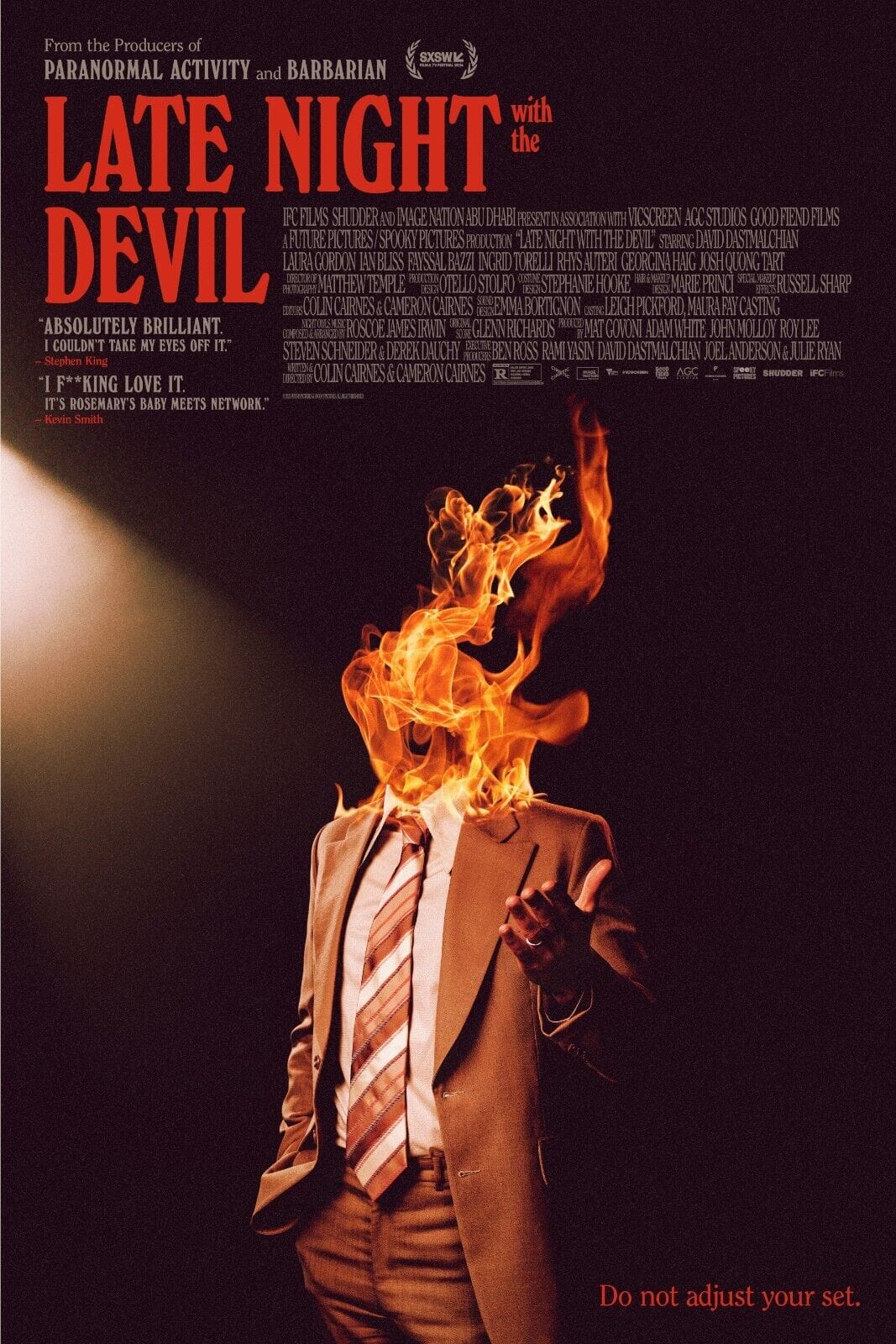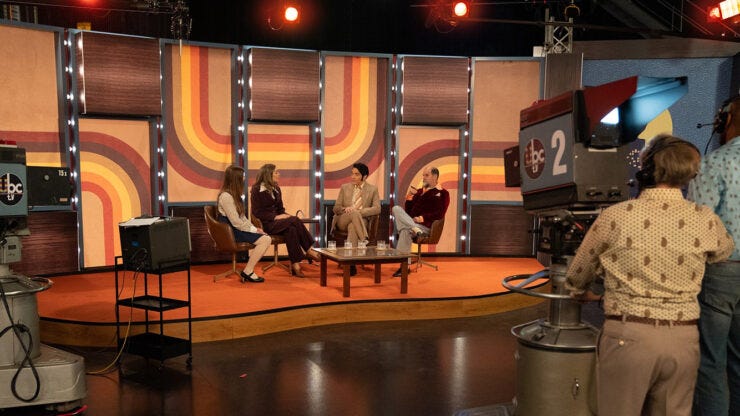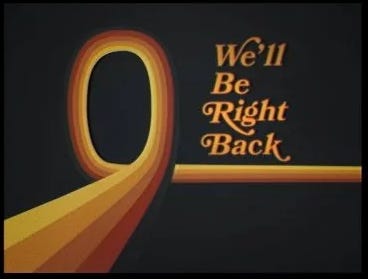Late Night with the Devil
“Ladies and gentlemen, please stay tuned for a live television first, as we attempt to commune with the Devil… but not before a word from our sponsors.”

A live television broadcast in 1977 goes horribly wrong, unleashing pure evil into the nation's living rooms.
Late Night With The Devil opens up with a montage of imagery, referencing events from the 60s and 70s that would one day help fuel that infamous era of hysterical idiot mass brain damage that would burn its way through America in the 1980s, known as the Satanic Panic.
Back then, the Satanic Panic was an every day state of being, infecting most of white Christian America with a shockingly dumb “bloody of tooth and claw” kind of dipshit paranoia. I remember hearing the sheriff in Algona, Iowa, back in 1989, when he went on the local radio station and stated out loud for everyone to hear, as if it were totally true, that on Halloween night, gangs of Satanists would be cruising the streets of that podunk trashheap little fuckhole of a town, on the look-out for any blonde-haired and blue-eyed virgin girls to snatch.
This dumb motherfucker actually said this shit in public and on the radio as it wasn’t an absolute fucking fantasy.
That’s how fucking dumb these people were then, and are now too, as this lunatic asshole belief has morphed into the incredibly vicious, incredibly stupid basis for the political and social agendas those same people push to this very day. It’s an always at the ready fear of this vague idea of “satanic pedophiles” that not only encapsulates the profound depths of their ignorance, as a shocking amount of them actually, truly, and sincerely believe this nonsense, but since the rest of them are all grifters who directly benefit from perpetuating this kind of garbage, or are just opportunistic habitual liars randomly seizing a chance for their own enrichment, it’s also something they use as either a smokescreen to obscure their unrelenting hatred for anyone who isn’t them, or as a cudgel, any time they need to violently batter their way to the front of the line to demand preferential treatment…
Honestly, for whatever reason, should you ever need to summarize to someone who and what Christianity truly is in America, the Satanic Panic—what it was and what it became—is all you need.
And so, with that time period firmly set in your mind, Late Night With The Devil begins on April 4th, 1971, when the first episode of the American television network UBC’s new late night show “Night Owls” goes on the air, starring former Chicago radio personality, Jack “Mr. Midnight” Delroy.

The show is an instant hit.
Which makes sense, as Jack Delroy is a member of The Grove.
A men’s only club in the Northern California redwood forests since the 1800s, the Grove, due to its high walls and private location, as well as the tales of weird going-ons within, the secret handshakes, the orgies, the arcane ceremonies, not to mention a membership that is supposedly made up of the country’s wealthy, powerful, and most favored, it is the type of place that is not only a real life nest of poisonous vipers and ugly pigs, but it is also a focal point for conspiracy-minded dullards the world over. The Grove especially draws the attention of the kind of creepy nutcases who are obsessed with chronicling any tall tale that involves child sex trafficking rings that cater specifically to the wealthy, powerful, and most favored, most especially if those stories also involve devil worship and/or cannibalism too.
Which a lot of them seem to... And why wouldn’t they? After all, what’s MORE depravity really mean at a certain point? In for a penny, in for a pound, I assume.
But I digress…
In the film, Jack Delroy is forever chasing the king of late night, Johnny Carson, but no matter what he does, no matter how hard he tries, he’s always second, much to his perennial disappointment. To make things worse, his wife is suddenly diagnosed with cancer, and she dies in 1976. Despite very publicly dealing with this, through it all, he still falls short of Carson in the ratings. After his wife’s death, Jack begins to seek out controversy in a desperate attempt to improve ratings, booking weirdos and freaks, and troublesome topics, but it’s all for naught as ratings take a nosedive.
Finally, on Halloween night in 1977, Jack Delroy does a live show…

First, Jack books a famous medium named Christou, a man who usually does cold readings, but who perhaps for the first time ever encounters the paranormal for real while on the show. Jack also books Carmichael Haig, a former stage magician turned debunker of ghost hunters, mediums, and mystics. Carmichael has an unsigned check for $100,000 in his pocket for anyone who can provide him with irrefutable proof of the paranormal, he’s also a man who desperately wants an invite to the Grove so that he can take part in the orgies.
Strange things start to occur on the show almost immediately, like how Christou struggles with the intense power of the spirits that he connects with, and also how he projectile vomits a viscous black liquid everywhere, before being taken to the hospital, where he dies…
All of which happens before they are even joined by the final guest of the evening, Dr. June Ross-Mitchell, author of the book “Conversations with the Devil.” The book is all about Lilly, and how, when Lilly was just ten years old, she was the only survivor of a satanic church that burned to the ground as it was raided by the FBI. Afterwards, Lilly began exhibiting some strange behavior, so Dr Ross-Michell was called in to help, and as it turns out, Lilly was possessed by the Devil… or at least, A devil.
Now, just three years later, Dr Ross-Mitchell has a book to sell, detailing the whole ordeal, and Lilly, an unnerving 13 year old girl who stares directly into the camera, joins her on the show. Lilly calls the thing that is crouched down inside her “Mr. Wiggles.” In actuality, it’s the demon Abraxas. A well-known trickster, as well as a show-off, not to mention the source of the magician’s incantation, “Abracadabra,” it is a creature that craves an audience. And now it has found itself on late night TV…
The rest of the movie is “the live tv event that shocked a nation!”
Name-checking such familiar ‘70s paranormal/supernatural touchstones like Amintyville and Ed and Lorraine Warren, all while relying on Owl imagery for its implied occult meanings, Late Night With The Devil is good, but the climax of the film is ultimately—sadly—unable to match the creativity and energy of its fantastic set-up and its escalating tension.
Plus, the tacked-on explanation of what occurred “in the Tall Trees” is completely unnecessary. This moment is a good example of a bad narrative decision. There’s no need to show a scene like this, especially when what it reveals was completely obvious the whole time, and especially when its inclusion only hurts the flow of the film more than anything else.
Sometimes less is more.
Also, while Late Night With The Devil is not exactly a POV horror film, it’s close enough that the Rules still apply. I’ve talked about POV films before and the Rules that, whether a filmmaker wants to acknowledge them or not, govern this particular kind of story telling. Basically, POV films are movies where one of the characters is holding the camera the whole time. Think Blair Witch or Cloverfield. Now, while none of the characters in this film are carrying the camera around in the way that defines POV films, it does all happen on the set of a late night talk show stage, both in front and behind the cameras, but mostly in front of them, as the show broadcasts live across the country, so at the very least, it’s POV-adjacent.
So, when it comes to making a POV film, the Rules are:
1. Never forget that the camera is a character.
2. Make sure to have a good reason for the characters to be filming in the first place.
3. Make sure to have a better reason for them to keep filming once the shit hits the fan.
4. Acknowledge that there is an inevitable point in every POV film where, no matter what, it will no longer make any sense at all for the characters to continue filming.
Now, like I said, this film isn’t a POV film in the strictest sense, but there’s a lot of overlap. Much like in POV films, due to story’s live TV set-up, the filmmakers have certain narrative tricks and tools now available to them to tell their story, to increase their tension, to hide twists, to make reveals, etc., but the flip-side of that is that those options also come with limitations.
Rules 2 and 3 the film has got covered pretty well. That all makes complete sense. Totally believable. It’s Rules 1 and 4 that it violates, and it does this by adding the “in the tall tress” scene. This story takes place during a TV show’s live studio broadcast. What we’re being show is everything that happened, the raw footage, including stuff that happens during the commercial breaks. The TV studio is your box, and your story has to stay confined to that box. You can’t show anything that happens outside of the studio, at least not without providing that option early on, which the film does not do. There’s no roving reporter, or man-on-the-street segments to this show. This is why we only hear that Christou has died. Why? Because it happens outside of the box that is the studio. Now, does the film push at the box’s boundaries a little by conveniently catching side conversations both backstage and during commercials? Yes, but that’s allowed, they’re telling a story here, and these moments all happen within the box.
So that’s Rule 1, forgetting that the camera is a character.
On top of that, by the time the “in the tall trees” scene rolls around, things have gone pretty off the rails at this point. In fact, it seems like the broadcast is over, so who is this scene being shown too? And that’s on top of the additional questions that come out of this scene showing up, like… who filmed the “tall trees” scene? Who brought it to the studio? Who showed it? Now, I could come up with answers, but that’s not how good stories work, right? The audience being required to come up with extra chapters in their heads in order to explain events in the film is a hallmark of a bad story. Like I’ve already said, this movie sets up its rules from the start, rules it follows throughout the story (at least until the end), and those rules are very easy to sum up: This happens during a live TV broadcast.
That’s great. I love it.
But that also means that once those cameras are off, then your story is done too. There’s just no way around this. That’s Rule 4. Failing to acknowledge the narrative brick wall that is Rule 4 is something that kills so many of these POV films, and often right at the finish line too. You gotta know when your story is done.
But just to be clear, this isn’t the main reason the film doesn’t work, it’s just something that annoys me. The main reason the film doesn’t quite work would be more due to a climax that falls victim to that old horror story axiom: “It is infinitely more scary to climb up those creepy attic stairs, to where the monster is hiding, and to then open that creaking attic door, then it is to actually see the monster itself.”
This is a movie that is really great for a lot of the time, but then it just kind of peters out. Key and Peele did the ending better too… Late Night With The Devil is fun, but in the end, its technical difficulties make it a little disappointing.

